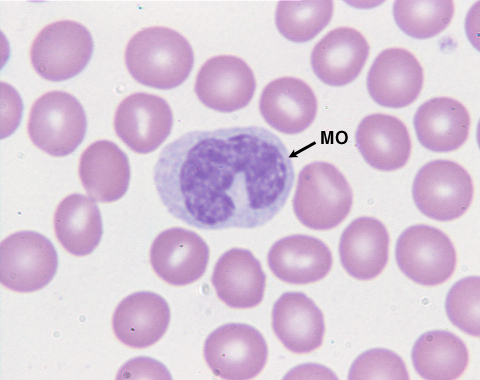Monocyte: Difference between revisions
Jump to navigation
Jump to search
Cleaned up the text. Added a link. Fixed a problem with the refs. |
Cleaned up the text. Cleaned up the references. |
||
| (One intermediate revision by one other user not shown) | |||
| Line 1: | Line 1: | ||
[[Image:Monocyte.jpg|right|221x175px|A photograph of a monocyte]] | [[Image:Monocyte.jpg|right|221x175px|A photograph of a monocyte]] | ||
Monocytes are a type of [[White blood cell|white blood cell]], they range from 13 μm to 25 μm in diameter and are distinguishable from their kidney-shaped [[ | Monocytes are a type of [[White blood cell|white blood cell]], they range from 13 μm to 25 μm in diameter and are distinguishable from their kidney-shaped [[Nucleus|nucleus]]. Monocytes originate from the common [[Myeloid progenitor|myeloid progenitor]] which differentiates to become a [[Granulocytes|granulocyte]] and then a monocyte. Monocytes are a [[Phagocytic|phagocytic]] cell found in the blood, they enter tissues and differentiate to form phagocytic [[Macrophage|Macrophages]]<ref>Murphy, K. (2012) Janeway's Immunobiology, 8th Edition, New York: Garland Science. p.4-6</ref>. Once matured monocytes are often found in the lymph nodes, spleen, bone marrow, and loose connective tissue<ref>Farlex Partner Medical Dictionary, 2012 found at: https://medical-dictionary.thefreedictionary.com/monocyte</ref><ref>Photograph of monocyte available from: http://imgarcade.com/monocyte.html</ref>. One key role monocytes play in immunity is the ability to differentiate into 2 different cell types - dendritic cells & tissue macrophages<ref>https://www.verywellhealth.com/what-are-monocytes-2252110</ref>. | ||
==== References: ==== | ==== References: ==== | ||
<references /> | <references /> | ||
Latest revision as of 06:36, 22 October 2018

Monocytes are a type of white blood cell, they range from 13 μm to 25 μm in diameter and are distinguishable from their kidney-shaped nucleus. Monocytes originate from the common myeloid progenitor which differentiates to become a granulocyte and then a monocyte. Monocytes are a phagocytic cell found in the blood, they enter tissues and differentiate to form phagocytic Macrophages[1]. Once matured monocytes are often found in the lymph nodes, spleen, bone marrow, and loose connective tissue[2][3]. One key role monocytes play in immunity is the ability to differentiate into 2 different cell types - dendritic cells & tissue macrophages[4].
References:
- ↑ Murphy, K. (2012) Janeway's Immunobiology, 8th Edition, New York: Garland Science. p.4-6
- ↑ Farlex Partner Medical Dictionary, 2012 found at: https://medical-dictionary.thefreedictionary.com/monocyte
- ↑ Photograph of monocyte available from: http://imgarcade.com/monocyte.html
- ↑ https://www.verywellhealth.com/what-are-monocytes-2252110